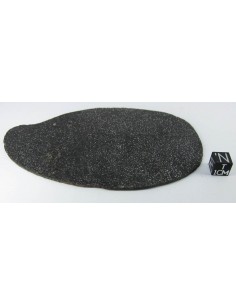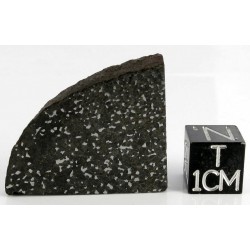- Lunar Meteorites
- Martian Meteorites
- Meteorite Classification
-
Buy Meteorites By Classification
- Lunar A
-
Iron Meteorites
- Campo Del Cielo Meteorites For Sale
- Meteor Crater Meteorite
- Meteorites From The Meteor Crater
- IIE Iron Meteorites
- Odessa Meteorite
- Gibeon Meteorite
- Octahedrites
- Hexahedrites
- Ataxites
- Silicated Iron
- Sikhote Alin Meteorite
- IAB Iron Meteorites
- IIAB Iron Meteorites
- IIC Iron Meteorites
- IID Iron Meteorites
- IIF Iron Meteorites
- IIG Iron Meteorites
- IIIAB Iron Meteorites
- IIICD Iron Meteorites
- IIIE Iron Meteorites
- IIIF Iron Meteorites
- IVA Iron Meteorites
- IVB Iron Meteorites
- Ungrouped Iron Meteorites
- Muonionalusta Meteorite
- IC Iron Meteorites for sale
- Canyon Diablo Meteorite
- Henbury
- IIIA Iron Meteorites
- Cape York Meteorite
- Unclassified Iron Meteorites
- Toluca Meteorite
- brenham Meteorite
- Gibeon Meteorites For Sale
- Plessitic Octahedrites
- Glorieta Mountain Iron Meteorite
- Seymchan Meteorite
- Wabar Meteorite
- La Caille Meteorite
- Lunar mare Basalt, lunar B
-
Carbonaceous Chondrites
- Carbonaceous chondrites CB
- Carbonaceous chondrites CI
- Carbonaceous chondrites CO
- Carbonaceous chondrites CM
- Carbonaceous chondrites CV
- Carbonaceous chondrites CR
- Carbonaceous chondrites CK
- Ungrouped Carbonaceous chondrites
- Carbonaceous Chondrites CH
- Carbonaceous Chondrite Grouplet
- Sutter's Mill Meteorite For Sale
-
Pallasites
-
Main Group Pallasites
- Esquel pallasite
- Imilac pallasite
- Fukang Pallasite
- Glorieta Mountain pallasite
- Krasnojarsk pallasite
- Marjalahti Pallasite
- Brahin Pallasite
- Huckitta Pallasite
- Seymchan Pallasite
- Brenham Pallasite
- Admire Pallasite
- Albin Pallasite
- Krasnoyarsk Pallasite
- Springwater Pallasite
- Ahumada Pallasite
- Imilac Meteorite
- Fukang Meteorite
- Krasnojarsk Meteorite
- Eagle Station Pallasites (ESP)
- Pyroxene Pallasites (PXP)
- Pallasites for sale
- Esquel Meteorite
- Eagle Station Meteorite
-
Main Group Pallasites
-
Chondrites
-
Achondrites
- Meteorite Thin Sections
- Stony-Iron Meteorites
- Tektites
- LUN-M, Mingled Mare
- Types of Meteorites
- LUN G (Lunar Gabbro), lunar meteorites
- Moon Meteorites
- pallasite
- Martian Meteorite
- Unique meteorites sold
- Videos of Meteorites
- lunar meteorite hunters
Ungrouped Achondrites
Ungrouped achondrites for sale
Ungrouped Achondrites
Many achondrites don’t fit easily into established classification schemes, and most of them are thought to be unique, and thus rather valuable samples of their respective parent bodies. Some of these ungrouped achondrites are evolved meteorites, similar to planetary meteorites, or HED achondrites, while others are clearly primitive achondrites, similar to brachinites, acapulcoites, or lodranites.
Evolved achondrites: An intriguing example of such an achondrite is NWA 011 (pairing with the NWA 2976), a small stone that was recovered from Northwest Africa in 1999. Originally, it was identified as a eucrite, but subsequent chemical and isotopic studies proved that it represents a new type of basaltic achondrite, genetically unrelated to the members of the HED group. Hence, NWA 011 is believed to represent a distinct parent body, an asteroid equally evolved and of a similar size as the HED parent body, 4 Vesta.
Another example is the most unusual Ibitira, a meteorite that fell in Brazil in 1957. Ibitira was also classified as an unique eucrite – it is unbrecciated, displays an unusual vesicular texture, and shows a formation age that predates most of the known HED members. More recently, detailed oxygen isotopic studies have shown that it’s more than likely that Ibitira isn’t a eucrite at all, but a meteorite from a so far unsampled differentiated asteroid that has yet to be determined.
Primitive achondrites: There are several ungrouped primitive achondrites, such as Divnoe or Zag (b), two meteorites that are closely related to the brachinite group. It has not yet been determined if these ungrouped primitive members originated on the same parent body as the brachinites and simply represent different degrees of thermal processing. Alternatively, they may have originated on one or more different parent bodies that share a similar history and composition to the brachinite parent body.
Some other interesting primitive achondrites are only represented by a single find, providing inadequate justification for the establishment of a new group. For example, our own find, ITQIY from Western Sahara, is primarily composed of the Mg-rich pyroxene, enstatite, and Ni-Fe metal, the texture Itqiy is like a lodranite.
There are 2 products.
Showing 1-2 of 2 item(s)


